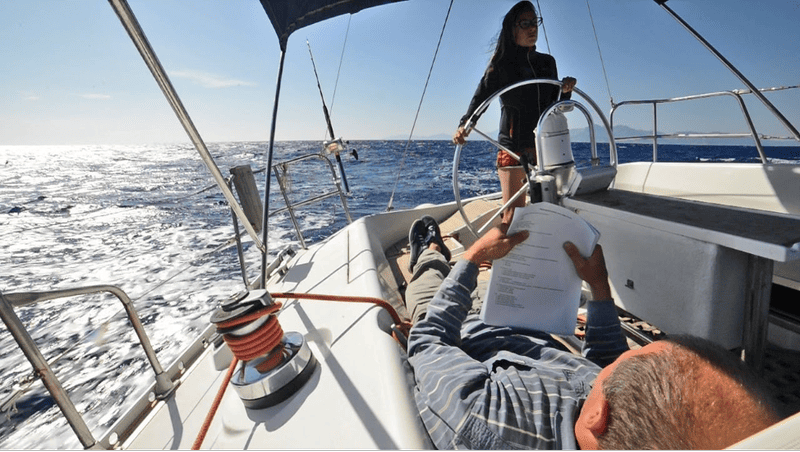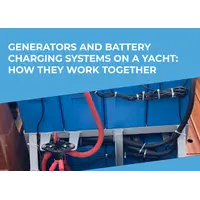topRik experts, based on their own experience in providing charter services, talk about the basic rules of behavior on a charter trip, safety precautions for the crew and tenants, as well as what rescue and signaling equipment is necessary on board a commercial yacht.

To be fair, it should be noted that, unfortunately, most of the requirements for ensuring navigation safety do not apply to pleasure yachts. The main document that regulates such requirements is the International Convention for the Safety of Life at Sea 1974 (SOLAS). This convention, as a general rule, does not apply to pleasure yachts not engaged in commercial transport. Only a few SOLAS rules are expressly applicable to all vessels, including yachts – like a rule about the presence of a sufficient number of lifebuoys, life jackets for the number of people on board, as well as a number of various instructions (instructions in case of an accident, for abandoning the ship, etc.) The SOLAS rules on the mandatory presence of a beacon, various radio communications, emergency light signals don’t apply to yachts though. Yachts are also not subject to mandatory equipping with GMDSS radio communication and radio navigation equipment.
According to the Convention on International Regulations for Preventing Collisions at Sea, 1972 (COLREG), a sailing vessel must exhibit side lights and a stern light. However, the requirements for navigation lights on a yacht are also very different (towards reduction and simplification) from the requirements for cargo or passenger ships.
But the practice of sailing, especially the practice of the charter business, forces each charter company to create its own rules in addition to the mandatory ones. It’s like that saying goes: “military regulations are written in blood,” - if this seems too radical in relation to charter sailing, look at the statistics of accidents associated with chartered yachts. Not all of the reasons for these tragedies lie in the poor training of tenant skippers. There are cases when the yacht was not provided with a sufficient number of life-saving equipment, or safety requirements were ignored by passengers.
What Rescue Equipment Must Be on Board a Yacht
Options for life-saving equipment depend on the region, as well as the cruising range. Let's consider several options for kits depending on the distance from the coast.

Rescue Equipment at a Distance from the Shore up to 2 Nautical Miles
The set includes life jackets for all passengers, including children and animals, a waterproof flashlight, a set of fire-fighting equipment: fire extinguishers, a fire blanket and a bucket with a metal handle and rope, a bailer and a hand pump.
All life jackets must be checked and in working order, and fire extinguishers must not be expired.
The set of life-saving equipment on a cruise yacht must include the following flags:
- signal - to give a distress signal;
- flag of the boat's nationality;
- quarantine or customs – in case of crossing interstate borders.
Rescue Equipment at Distances From Shore up to and More Than 60 Nautical Miles
The main condition for going to sea is the presence of enough life rafts capable for all passengers on board and for ensuring their life safety for 24 hours. The life raft must be in good condition - a new raft is checked first after 5 years, and then every 3 years.
The set of rescue equipment should also include lifebuoys, flares, orange smoke and red flares.
It would also be useful to have an emergency radio beacon or an emergency satellite communications buoy on the yacht, as well as a weather station or weather fax. You should keep an eye on what weather is expected while sailing.
Another important part of safe navigation is the presence of a sea anchor or storm anchor on the yacht. Its task is to allow you to safely wait out the storm at sea.
The completeness and expiration dates of life-saving equipment must be checked by the skipper before going to sea. It is imperative to instruct the crew, including on safety equipment: how and when to use life-saving equipment.

Safety Briefing on a Charter Yacht
A yacht, especially a sailing one, is already quite a dangerous vehicle, even when moored at the pier in the marina. What can we say about a yacht that is underway, facing numerous challenges from the aggressive marine environment.
The sea does not forgive mistakes... and does not suffer fools. Ok, let’s replace this last word with "frivolous people."
But in any form, anyone with at least some experience of going to sea independently will agree with this statement - the cost of error here is really high. Therefore, increased attention and strict adherence to safety precautions are required from the yacht captain and his crew. This is especially true in the charter business, where it is difficult to determine the level of training of the crew that goes on deck. It's a little easier if the boat is rented with a skipper. But in any case, the captain must conduct an introductory briefing with the participants of the voyage on safety precautions, behavior on board and relationships, in particular with the captain of the yacht.
The variety of different unpleasant incidents is difficult to list, and it is hardly possible to do it at all. A modern charter yacht is nothing more than a collection of technically complex systems. Yacht safety includes the ability to competently use and operate these systems to navigate without accidents.
A sailing yacht, for example, due to its design features, sometimes experiences incredible loads while underway. Moving on a close-hauled course (at an acute angle to the direction of the wind), the yacht tilts, the deck becomes wet from splashes and waves. Even simply moving around the deck at these moments becomes dangerous, especially for an inexperienced crew.
It is no secret that in most cases, the crews of charter yachts consist of inexperienced yachtsmen. Often only one captain is familiar with the safety rules on the yacht. And even then he might have forgotten some things since he graduated from yachting school. The help of the crew when working with sails and, of course, when mooring will be vital for the skipper. All these processes, and life itself on a yacht, sometimes take place in extreme sea conditions.

Therefore, in order to avoid unnecessary injuries, any unpleasant incidents, technical accidents and breakdowns, the captain of a charter yacht (provided by the charter company or the renter) is simply obliged to conduct an initial safety briefing before going to sea, when checking into the yacht.
- Before setting off on your charter yacht cruise, check if all the equipment is present on board. If your crew plans to actively participate in the management of the yacht, special shoes and gloves are helpful.
- If there are children on charter, explain to them that running around the piers is prohibited. There may be mooring ropes or electrical wires on the berths - it's easy to trip and get seriously injured.
- Tell the crew (passengers) how to safely board and disembark, depending on how the yacht is moored – side-to or stern-to. Explain that only one person can be on the ramp at a time.
- Demonstrate how to safely descend into the saloon and move around inside the yacht.
- Provide instruction on how to use marine latrines. Let us remind you that only what has passed through the human body should go into a sea latrine of any type. The smallest piece of toilet paper or even an olive pit will clog the system. In the case of electric latrines, this also leads to damage to the impeller. In this case, the loss of part of the security deposit is guaranteed.
- Give clear instructions on how to use the water system and instruct the crew not to keep fresh water pump on all the time. Increased pressure in the system, especially while driving, leads to breakdowns.
- Explain how to use the tool panel and electrical equipment in general on a yacht. Excessive consumption must be eliminated; the autonomy of a charter yacht is always limited.
- Show where all fire extinguishers are located in the saloon and cockpit lockers.
- Point out where they are and show how to use life jackets. The same goes for storm harnesses. In fresh weather or when sailing, your crew ideally should always wear vests while on deck. If you have children in your crew, pick up extra children's life jackets from the charter company office.
- Provide detailed instructions on how to use a gas stove. Show where the fire blanket is. Fire blanket should be located in close proximity to the stove in the galley. Let us remind you that it is necessary to keep bottles with vegetable oil away from the gas stove.
- When sailing or powering, the crew must always be in the cockpit of the yacht. But there may be situations when it is necessary to carry out some operations at the mast or on the forecastle. Show how to safely navigate the deck using three points of support. For crews with children, we recommend renting the safety net from the charter company. This is a special net that is attached to the yacht's fan posts and prevents it from falling overboard.
- Find and show the crew where the emergency tiller is and how to use it.
- At least one member of the charter party in addition to the skipper must be able to start the boat's engine, engage forward and reverse, and know how to engage and stop the autopilot.
- Safety on a yacht also includes proper handling of the spar and rigging of the yacht. Pay special attention to the crew about the danger of the boom.
- Explain and show how to work correctly with running rigging. When working with rigging, it is mandatory to wear special yachting gloves. Tell others which ends are under particularly heavy load. Be sure to show how to use spinlocks.
- Working with rigging primarily means using winches. Winches are also one of the main sources of danger when a yacht is sailing. Show how to correctly wind the sheets onto the winch and how to fix them in the winch stops. Please note to passengers that long hair that flutters beautifully in the wind, if caught in the winch, will lead to tragic consequences. Show how to properly use winch handles. The winch handles should always be in their normal places in the pockets and immediately put back after use. If your yacht is equipped with electric winches, pay special attention to them. Lack of competency when working with such a winch or an incorrectly wound end lead to sad accidents too. Give clear instructions on how to haul and remove sheets using winches.
- Safety on a yacht also means proper, safe mooring. The mooring process itself is a technologically complex, rather dangerous and nerve-wracking event for the yacht captain. Depending on the type of mooring, be sure to assign roles to crew members and explain the responsibilities of each member. These roles should not change to avoid confusion. Show how to choose the right mooring and use them. Be sure to show how to give and receive mooring lines, correctly guide them to the cleats (bollards) and fix them. Arrange a little training session: let your crew, breaking into pairs, try to go through the moves several times. An unintended knot on the mooring line when leaving the pier is a recipe for problems! An incorrectly placed mooring line can easily break any deck equipment, which leads to the inevitable waste of the security deposit.
- Prohibit your crew from pushing away from neighboring yachts while mooring, or from sticking their arms and legs between yachts - show them how to use fenders.
- If you plan to anchor overnight, provide instructions on how to safely release the anchor without damaging the bow of the yacht. Explain how to use an anchor winch safely.
- After purchasing provisions, try to optimally arrange all the products in the galley. Before heading out to sea, make sure all items are secured and all lockers are closed. Have each member of your crew check their cabin.
- Be sure to close all hatches and windows before going out to sea. A wave can flood your bed, and that's the lesser of two evils. Much more dangerous is sea water entering the electrical systems of a charter yacht.
- Check the weather forecast before heading out to sea. If the weather worsens, if you are not confident in your strength or the strength of your crew, it is better to stay in the marina or port. On stormy days, it is better to devote time to exploring the sights on the shore and relaxing.

Safety on a yacht is the captain's main concern. The captain is obliged to return the vessel and crew entrusted to him safely and on time to the base of the charter company. When making decisions, be guided by good seamanship practice, always considering yourself closer to danger than you actually are. Caution, attention and composure in any situation are all signs of a real skipper.
Briefing before going to sea should last for about two hours – it’s not that much if it saves your life. Complete the briefing with the message that the captain on the ship is second only to God, and the crew and passengers must obey him unquestioningly during the trip.
That’s all for now – stay tuned for more articles regarding charter business practices from topRik and good luck on all your journeys!








